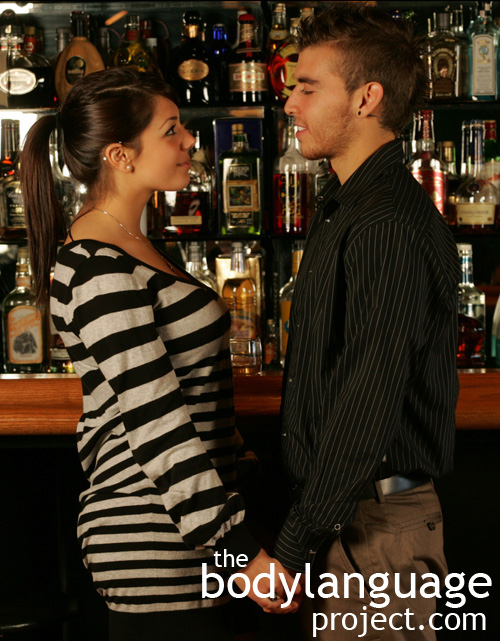Body Language of The Intimate Gaze or Triangular Gaze Pattern
 Cue: Intimate Gaze (The) or Triangular Gaze Pattern
Cue: Intimate Gaze (The) or Triangular Gaze Pattern
Synonym(s): Triangular Gaze Pattern, Seducer Gaze.
Description: If interest is mutual and conversation arises, scanning of the face will take place. The eyes will form a triangular pattern from eye-to-eye and down to the mouth or chin. The eyes will also wander briefly to other parts of the face, but the vast majority of time will be spent looking at the eyes and mouth. Gaze duration during intimacy lasts in bouts of approximately four to five seconds. When the eyes finally do leave the face they will check out the rest of the body, to examine clothing, overall build, jewelry and rings.
In One Sentence: The intimate gaze pattern indicates sexual feelings.
How To Use it: Use the intimate gaze pattern to show others that you are romantically interested in them. This is an effective signal when done by both men and women.
Context: Dating.
Verbal Translation: “I like you sexually so I’m being respectful to check out your emotional cues which are found in your eyes, face and mouth, but I’m also making visual forays to the rest of your body including your chest and privates.”
Variant: See Staring or The Evil Eye, Eye Aversion, Gaze Avoidance and Wandering Eyes, Business Gaze, Face Gaze, Friendly Social Gaze.
Cue In Action: As Bill and Debbie spoke, they followed a characteristic gaze pattern from the eyes to the mouth, but also to the rest of the body.
Meaning and/or Motivation: If the eyes of men and women meet and there is a spark, the eyes will follow specific patterns across the face to form an intimate gaze. When eye contact is broken it usually happens by looking down. Looking down punctuates sexual interest. Looking sideways is a willful indication that one is scanning the room entirely and is not checking someone else out.
Both sexes, despite social norms, will glance over more intimate areas of the body such as the crotch and breasts coupled with the intimate gaze as described above. Men tend to check women out from the ground up, starting from the legs, then to the crotch, torso, breasts, shoulders, then face. The vast majority of women find being scanned by men to be a turn-off, however, studies show that women habitually check men out just as often, they simply do it much more discretely.
Cue Cluster: Expect to see additional courtship cues such as neck and wrist exposure, batting of the eyes, touching the neck, grooming, in women, puffing out the chest, and hands on the hips, in men.
Body Language Category: Courtship display, Eye Language, Indicators of sexual interest (IOsI), Liking.
Resources:
Argyle, Michael; Lefebvre, Luc; Cook, Mark 1974. The meaning of five patterns of gaze. European Journal of Social Psychology. 4(2): 125-136.
Argyle, M., and Ingham, R. 1972. Gaze, mutual gaze, and proximity. Semiotica, 1, 32–49.
Argyle, M. and Cook, M. Gaze and Mutual Gaze. London: Cambridge University Press, 1976.
Allan Mazur; Eugene Rosa; Mark Faupel; Joshua Heller; Russell Leen; Blake Thurman. Physiological Aspects of Communication Via Mutual Gaze. The American Journal of Sociology. 1980; 86(1): 50-74.
Breed, G., Christiansen, E., & Larson, D. 1972. Effect of lecturer’s gaze direction upon
teaching effectiveness. Catalog of Selected Documents in Psychology, 2: 115.
Ellsworth, Phoebe; Carlsmith, J Merrill. 1973. Eye contact and gaze aversion in an aggressive encounter. Journal of Personality and Social Psychology. 28(2): 280-292.
Foddy, Margaret 1978. Patterns of Gaze in Cooperative and Competitive Negotiation
Human Relations. 31(11):925-938.
Hall, Jeffrey A. and Chong Xing. The Verbal and Nonverbal Correlates of the Five Flirting Styles. Journal of Nonverbal Behavior. 2015. 39:41–68. DOI 10.1007/s10919-014-0199-8
http://bodylanguageproject.com/articles/first-12-minutes-flirting-using-nonverbal-communication-study-reveals-26-body-language-cues-attraction/
Kellerman. 1989. Looking and loving: The effects of mutual gaze on feelings of romantic love. Journal of Research in Personality. 23(2): 145-161.
Kendon, A. Some Functions of Gaze Direction in Social Interaction. Acta Psychologica. 1967. 32: 1-25.
Kleinke, C. L. 1980. Interaction between gaze and legitimacy of request on compliance in a field setting. Journal of Nonverbal Behavior 5(1): 3-12.
Leeb. 2004. Here’s Looking at You, Kid! A Longitudinal Study of Perceived Gender Differences in Mutual Gaze Behavior in Young Infants Source: Sex Roles. 50(1-2): 1-14.
Langer, Julia and Rodebaugh, Thomas. Social Anxiety and Gaze Avoidance: Averting Gaze but not Anxiety. Cognitive Therapy and Research, 2013, Vol.37(6): 1110-1120.
McAndrew. 1986. Arousal seeking and the maintenance of mutual gaze in same and mixed sex dyads Source: Journal of nonverbal behavior. 10(3):168-172.
Mulac, A., Studley, L., Wiemann, J., & Bradac, J. 1987. Male/female gaze in same-sex
and mixed-sex dyads. Human Communication Research. 13: 323-343.
Moore, Monica. Courtship Signaling and Adolescents: Girls Just Wanna Have Fun. Journal of Sex Research. 1995. 32(4): 319-328.
http://bodylanguageproject.com/articles/girls-just-want-to-have-fun-the-origins-of-courtship-cues-in-girls-and-women/
Natale, Michael. 1976. A Markovian model of adult gaze behavior. Journal of Psycholinguistic Research. 5(1): 53-63.
Phelps, F., Doherty-Sneddon, G., & Warnock Educational Psychology., 27, 91-107. (2006). Functional benefits of children’s gaze aversion during questioning. British Journal Developmental Psychology. 24: 577-588.
Rosenfeld, H., Breck, B., Smith, S., & Kehoe, S. 1984. Intimacy-mediators of the proximity-gaze compensation effect: Movement, conversational role, acquaintance, and gender. Journal of Nonverbal Behavior. 8: 235-249.
Williams. 1993. Effects of Mutual Gaze and Touch on Attraction, Mood, and Cardiovascular Reactivity Source: Journal of Research in Personality. 27(2): 170-183.
